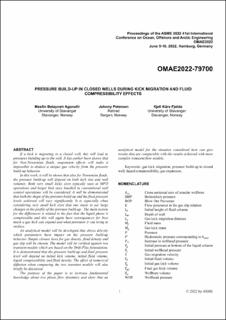| dc.contributor.author | Agonafir, Mesfin Belayneh | |
| dc.contributor.author | Petersen, Johnny | |
| dc.contributor.author | Fjelde, Kjell Kåre | |
| dc.date.accessioned | 2023-04-03T10:59:22Z | |
| dc.date.available | 2023-04-03T10:59:22Z | |
| dc.date.created | 2022-11-03T11:49:36Z | |
| dc.date.issued | 2022 | |
| dc.identifier.citation | Agonafir, M.B., Petersen, J., & Fjelde, K.K. (2022). Pressure Build-Up in Closed Wells During Kick Migration and Fluid Compressibility Effects. Volume 10: Petroleum Technology. | en_US |
| dc.identifier.isbn | 978-0-7918-8595-6 | |
| dc.identifier.uri | https://hdl.handle.net/11250/3061776 | |
| dc.description.abstract | If a kick is migrating in a closed well, this will lead to pressures building up in the well. It has earlier been shown that for Non-Newtonian fluids, suspension effects will make it impossible to deduce a unique gas velocity from the pressure build-up behavior.
In this work, it will be shown that also for Newtonian fluids, the pressure build-up will depend on both kick size and well volumes. Both very small kicks sizes typically seen in MPD operations and larger kick sizes handled in conventional well control operations will be considered. It will be demonstrated that both the shape of the pressure build-up and the final pressure levels achieved will vary significantly. It is especially when considering very small kick sizes that one starts to see large changes in the profile of the pressure build-up. The main reason for the differences is related to the fact that the liquid phase is compressible and this will again have consequences for how much a gas kick can expand and what pressures it can bring to surface.
An analytical model will be developed that shows directly which parameters have impact on the pressure build-up behavior. Simple closure laws for gas density, fluid density and gas slip will be chosen. The model will be verified against two transient models which are based on the Drift-Flux formulation. It is demonstrated that the pressure build-up and final pressure level will depend on initial kick volume, initial fluid volume, liquid compressibility and fluid density. The effect of numerical diffusion when comparing the two transient models will also briefly be discussed.
The purpose of the paper is to increase fundamental knowledge about two phase flow dynamics and show that an analytical model for the situation considered here can give results that are comparable with the results achieved with more complex transient flow models. | en_US |
| dc.language.iso | eng | en_US |
| dc.publisher | American Society of Mechanical Engineers | en_US |
| dc.relation.ispartof | Proceedings of ASME 2022 41st International Conference on Ocean, Offshore & Arctic Engineering | |
| dc.title | Pressure Build-Up in Closed Wells During Kick Migration and Fluid Compressibility Effects | en_US |
| dc.type | Chapter | en_US |
| dc.description.version | acceptedVersion | en_US |
| dc.rights.holder | The owners/authors | en_US |
| dc.subject.nsi | VDP::Teknologi: 500 | en_US |
| dc.identifier.doi | 10.1115/OMAE2022-79700 | |
| dc.identifier.cristin | 2068554 | |
| cristin.ispublished | true | |
| cristin.fulltext | postprint | |
| cristin.qualitycode | 1 | |
